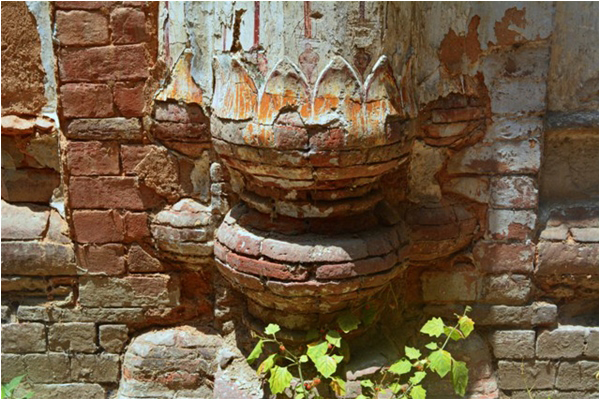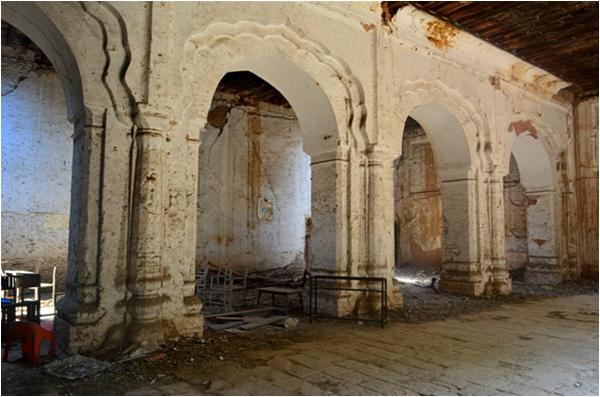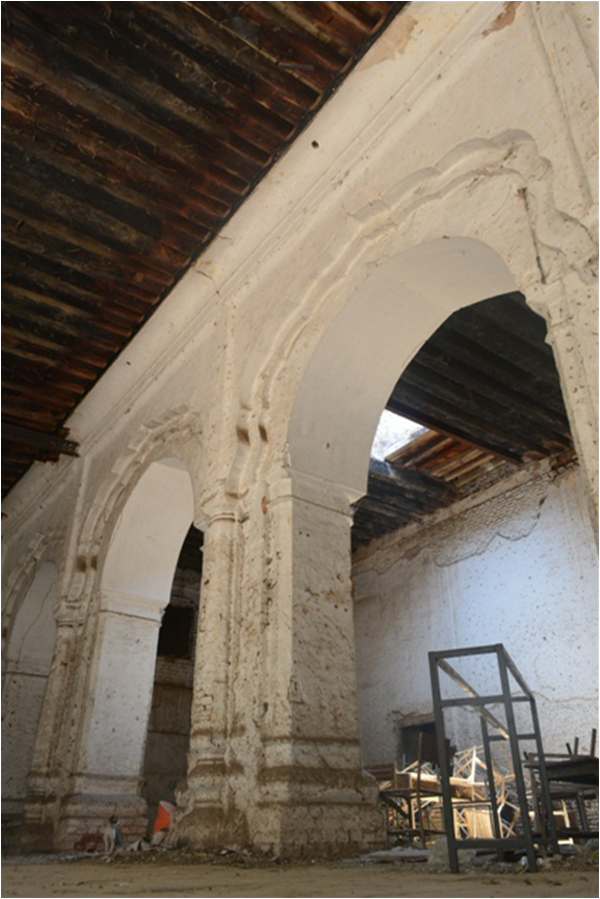Ruins of Haveli Dhiyan Singh
by Nadeem Dar
Friday Times 12 June 2015

The haveli once had sixty two rooms
While having coffee with a friend on a Saturday night, and discussing various heritage locations for photography, I found out about a haveli inside Taxali Gate – one of the thirteen gates of the Walled City of Lahore. I was astonished to find out that it was the birth place of the Government College Lahore, now known as Government College University. I, like many others, had always associated Taxali Gate with music and dance because of the Red Light Area and never thought that the place would be so enriched with heritage.
Early next morning, I reached Taxali Gate. Phaja Paye Wala (a local cuisine) tempted me to stop for a heavy breakfast, after which I took to one of the streets near Said MithaBazaar passing through an alley. I saw an old arch leading into a vast courtyard: thehaveli of Raja Dhiyan Singh.

Piles of debris, damaged school furniture, stacked in the hall

A notice board warning visitors against damaging the building

Reduced to 2 kanals after encroachments and division of land
I had always associated Taxali Gate with music and dance
The same haveli my friend was talking about. Luckily I met a small boy playing in the courtyard who told me about the guard who has the keys to the haveli. I met the guard and requested him to open up the gate. I told him that I wanted to capture images of the place. After a few arguments and reluctance on his part, the guard agreed to let me in.
I entered a huge hall which was the court of Raja Dhiyan Singh. The haveli was in shambles and pigeons and cats were the only form of life found there, other than the guard and myself. Piles of debris, damaged school furniture were stacked in the middle of the hall. The autumn leaves spread around mirrored the neglected conditions of thehaveli.
I could not believe that the place I was photographing was the birth place of Government College of Lahore. The initial classes of Government College, and simultaneously the Oriental College, started in this building in 1864. The haveli had sixty two rooms at that time.

The lotus flower petals on the pillars resemble the architecture of Lahore Fort

The remains of fresco work are still there

I met a boy playing in the courtyard who told me about the guard with the haveli’s keys
Originally this haveli covered an area of 47 kanals but it was reduced to 2 kanals after encroachments and division of land. The historic accounts state that this haveli was larger than the haveli of Jamadar Khushal Singh, which is now the Chuna Mandi Girls College.
It was depressing to see that the foundation of an institute, which gave identity to many leaders, was in ruins today. And nobody to look after it…
The guard, gauging my passion, told me that it was the haveli of Raja Dhiyan Singh, who was born in 1796. The Raja along with his two brothers served Maharaja Ranjit Singh. According to Sikh history, Raja Dhiyan Sigh was one of the successful workers who gained respect and rose from the post of a trooper to a deorhidar or chamberlain to the royal household. In this capacity, he had ready access to the Maharaja and became a man of influence at the court. Later in 1822 he was made the Raja and gifted with land in Jammu and Punjab where we see the remains of his astounding palace today. Raja Dhiyan Singh became the prime minister of the court and died in 1843.



The balcony for public hearing is still intact in the hall
Pigeons and cats were the only form of life found there
The existing part of the haveli was the court of Raja Dhiyan Singh while the other portions have been demolished. The balcony for public hearing is still intact in the hall. The small ventilation openings in the floor endorse the presence of a basement. The main door leading to the basement now is covered with cobwebs and the staircase is sealed.
According to the guard he had seen the basement in his childhood. It was huge and used as a private chamber by the Raja. The haveli must have been a masterpiece embellished with ornaments and fresco work as per Sikh architecture. The remains of fresco work are still there in the haveli. It was a two storey building and at present the upper storey is being used as a residential part by the locals.
The construction of the building goes back to the Mughal era. The arches and features of the building reflect a mix of Mughal and Sikh architecture. The lotus flower petals on the pillars of the main hall and the jharoka, or balcony, made for public hearing, resemble the architecture of Lahore Fort and other buildings of that era.


The door leading to the basement now is covered with cobwebs
It was larger than the haveli of Jamadar Khushal Singh
After the fall of Sikh rule the palace was turned it into a school by the British, in 1854. Ten years later in 1864 it became the house of the Government College and Oriental College Lahore. As per history of Government College, it was to be opened up in 1856, but the tough criteria of foreign qualified teachers delayed it till 1864. After a few years in 1871, the Government College was moved near Anarkali.
After the shifting of the colleges, the premises were used as Dhiyan Singh School which after 1947 was named as City Muslim League High School. Till 2004 the haveli was used as a boys’ school, but following a fire incident, the building was damaged and the school was shifted.

The arches and features of the building reflect a mix of Mughal and Sikh architecture

This is one sad story of our heritage. Not many of us know this place or the fact that Government College starting from this haveli. It should be turned into a tourist site by the concerned department, in order to save it from further deterioration. At present the haveli is under the possession of the Education Department of Punjab and some land has already been shared with the Government of Jammu Kashmir.
Other nations respect their heritage and cherish the old remains. We forget and neglect what we have of our ancestors. I hope to see this Haveli in a better state when I visit it the next time.
The writer is a professional heritage photographer and can be reached at nadeemdarphotography@gmail.com